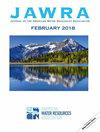喀麦隆西部地区恩廷格社区生活水质评价
IF 2.6
4区 环境科学与生态学
Q3 ENGINEERING, ENVIRONMENTAL
引用次数: 0
摘要
本研究调查了喀麦隆西部地区Menoua省Santchou市Nteingue社区(一个村庄)使用的三个主要水源的质量,以便根据世界卫生组织(WHO)的指导方针确定其是否适合家庭使用。该地区的居民在未经任何事先处理的情况下饮用来自这些水源的水,如果水源受到污染,可能导致健康问题。在2022年的旱季和雨季,对三个水源:Plantain市场的一个泉水、恩廷盖市场的一个水龙头(利用的泉水)和恩廷盖-姆博特乌克地区的一口露天水井进行了取样,并使用世卫组织建议的标准方法检查了感官、物理化学和细菌学参数。除了雨季的春天有微小的黑色碎片外,水样的感官特征还可以接受。物理参数结果显示中酸性至中性水(5.6-7.2),矿物质含量低,溶解固体和浊度低。所有主要离子均在世卫组织指导值范围内。hco3和K +浓度变化有显著的季节差异(p <0.05)。水源是本文章由计算机程序翻译,如有差异,请以英文原文为准。
Domestic Water Quality Assessment in Nteingue Community, West Region of Cameroon
This study investigated the quality of three main sources of water used in Nteingue community-a village in Santchou municipality of the Menoua division, West Region of Cameroon, in order to determine its suitability for domestic use following World Health Organisation (WHO) guidelines. Inhabitants of this locality consume water from these sources without any prior treatment, which can result in health problems if the water sources are contaminated. Three water sources: a spring in Plantain market, a tap (harnessed spring) in Nteingue market, and an open well in Nteingue-Mbouteuc quarter were sampled in the dry and rainy seasons of 2022 and examined for organoleptic, physicochemical and bacteriological parameters using standard methods recommended by WHO. Water samples had acceptable organoleptic characteristics except for the spring in the rainy season which was clear with tiny dark debris. Results of physical parameters revealed moderately acidic to neutral waters (5.6-7.2) with low mineral content, dissolved solids and turbidity. All major ions were within the WHO guideline values. There were significant seasonal differences observed in the variations of the concentrations of HCO 3-and K + (p <0.05). The water sources were
求助全文
通过发布文献求助,成功后即可免费获取论文全文。
去求助
来源期刊
CiteScore
4.10
自引率
12.50%
发文量
100
审稿时长
3 months
期刊介绍:
JAWRA seeks to be the preeminent scholarly publication on multidisciplinary water resources issues. JAWRA papers present ideas derived from multiple disciplines woven together to give insight into a critical water issue, or are based primarily upon a single discipline with important applications to other disciplines. Papers often cover the topics of recent AWRA conferences such as riparian ecology, geographic information systems, adaptive management, and water policy.
JAWRA authors present work within their disciplinary fields to a broader audience. Our Associate Editors and reviewers reflect this diversity to ensure a knowledgeable and fair review of a broad range of topics. We particularly encourage submissions of papers which impart a ''take home message'' our readers can use.

 求助内容:
求助内容: 应助结果提醒方式:
应助结果提醒方式:


